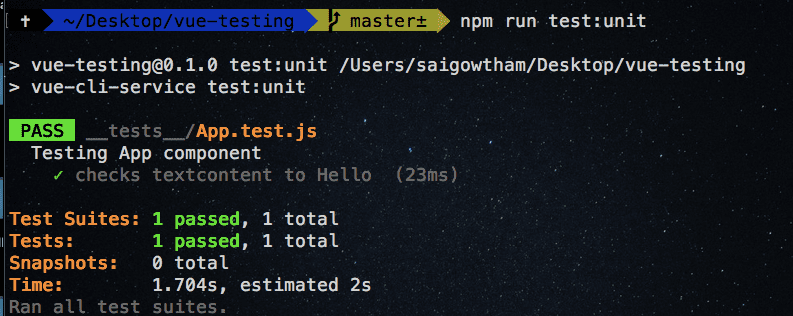A beginners guide to Vue unit testing with Jest
In this tutorial, we are going to learn about how to write unit tests for vue components using jest
and vue-test-utils.
What is Jest?
Jest is a JavaScript unit testing framework created by facebook which includes a lot of features like snapshot testing, code coverage, etc.
Vue-test-utils
The vue-test-utils library provides us helper methods by using that we can mount and interact with the Vue components easily.
Getting started
First, we are going to create a new vue project by using Vue CLI.
Open your terminal and run the following command.
vue create vue-testingIt will prompt with two options, select manually select features and hit enter.
Vue CLI v3.0.0
? Please pick a preset:
default (babel, eslint)
❯ Manually select featuresNow, you need to select unit testing option by using the Space key.
Vue CLI v3.0.0
? Please pick a preset: Manually select features
? Check the features needed for your project:
◉ Babel
◯ TypeScript
◯ Progressive Web App (PWA) Support
◯ Router
◯ Vuex
◯ CSS Pre-processors
◉ Linter / Formatter
❯◯ Unit Testing
◯ E2E Testingchoose ESLint with error prevention only option and hit enter.
Vue CLI v3.0.0
? Please pick a preset: Manually select features
? Check the features needed for your project: Babel, Linter, Unit
? Pick a linter / formatter config: (Use arrow keys)
❯ ESLint with error prevention only
ESLint + Airbnb config
ESLint + Standard config
ESLint + PrettierNow, choose Jest option and hit enter.
Vue CLI v3.0.0
? Please pick a preset: Manually select features
? Check the features needed for your project: Babel, Linter, Unit
? Pick a linter / formatter config: Basic
? Pick additional lint features: Lint on save
? Pick a unit testing solution:
Mocha + Chai
❯ JestIt will ask for where to place configurations choose package.json.
? Where do you prefer placing config for Babel, PostCSS, ESLint, etc.?
In dedicated config files
❯ In package.jsonFinal question type N and hit enter and vue cli starts creating our project with jest and vue-test-utils.
Run the below command in your terminal to change your current working directory.
cd vue-testingNow open your vue-testing project in your favorite code editor, you will see a tests folder which is generated by the vue cli delete this folder.
Remove everything from a App.vue file and add the below code.
<template>
<div id="app">
<h1>{{msg}}</h1> </div>
</template>
<script>
export default {
data: function() {
return {
msg: "Hello"
};
}
};
</script>This is our App component with h1 element and msg data property.
Writing our first unit test
Now we are writing a unit test for our App component.
create a new folder called __tests__ in your root directory, because by default jest looks for __tests__ folder in your vue project and runs all tests present inside that folder.
create a new file called App.test.js inside __tests__folder and add the below code.
.test.js is an file extension.
import App from '../src/App.vue'
import { mount } from '@vue/test-utils';
describe('Testing App component', () => {
it('checks textcontent to Hello ', () => {
const wrapper = mount(App); //returns instance of the component. //accessing dom element and checks textcontent
expect(wrapper.element.textContent).toBe('Hello'); })
})In the above code, we first imported the App component and mount method.
The mount method takes a component as an argument and returns its vue instance and dom node.
Let’s run our test by using the below command.
npm run unit:testNow you will see a pass check like in the below image.
Watch mode
Now if we create another test in our vue app or if we update our existing tests, we need to re-run the test command again and again, by using watch mode jest automatically re-run the tests if something has changed in the test files.
Open your package.json file and replace your test:unit script with below script.
"test:unit": "vue-cli-service test:unit --watch"Writing our second test
Let’s write our second test.
import App from '../src/App.vue'
import { mount } from '@vue/test-utils';
describe('Testing App component', () => {
it('checks textcontent to Hello ', () => {
const wrapper = mount(App);
expect(wrapper.element.textContent).toBe('Hello');
})
it('checks textcontent to Hi', () => {
const wrapper = mount(App, {
data: function () {
return {
msg: "Hi" // replacing msg property value with `Hi` }
}
})
expect(wrapper.element.textContent).toBe('HI');
})
})In our second test, we are checking for textContent to be Hi by passing a data option as a second argument to mount method.
Now in your terminal, you’ll see two tests are passing.
Further, you can check out vue-test-utils website to know more about helper methods.






